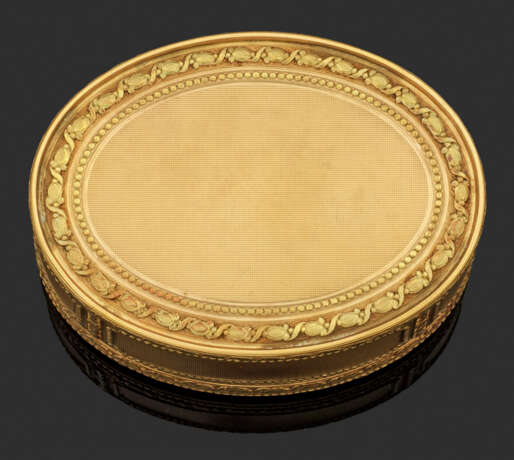ID 1185492
Lot 3 | Feine Louis XVI-Goldtabatiere à Deux Couleurs
Estimate value
€ 8 500 – 17 000
Provenienz: aus der über Generationen gewachsenen und bedeutenden Sammlung der Frankfurter Bankiersfamilie von Bethmann.
Diese Tabatiere ist ein typisches Beispiel für die im Stil der Pariser sowie auch der Schweizer Goldschmiede hergestellten Golddosen des 18. Jhs.; Paris galt in dieser Zeit als das europäische Goldschmiede-Zentrum. och auch Hanau entwickelte sich in den 1760ern, u .a. durch den Einfluss der französischen Goldschmiedekunst in Europa und durch eine Vielzahl zugezogener Goldschmiede hugenottischer Herkunft zu einer bedeutenden Produktionsstätte für Gold-Tabatieren und konnte mit der hohen Qualität und dem feinen Design Frankreichs mithalten. Werke der Hanauer Goldschmiede befinden sich heute in namhaften Museen wie dem Metropolitan Museum in New York, dem Musée Cognac-Jay in Paris oder der Fürstlichen Schatzkammer Thurn und Taxis in Regensburg. Die auf dieser Tabatiere befindliche Herstellermarke "EC" unter Lilie und Krone ist von Lorenz Seelig in seinem 2015 im Silver Society of Canada Journal (S. 45, 46, Fig. 50) veröffentlichten Artikel "Eighteenth Century Hanau Gold Boxes" abgebildet und wird dort dem Hanauer Bijoutier, Esaias Fernau ("Esaias et Compagnie") zugeschrieben. Fernau war ab ca. 1762 tätig und arbeitete mit verschiedenen Partnern wie z. B. mit Daniel Marchand oder dem Emailleur Friedrich Wagenfuehrer zusammen. Eine Fernau zugeschriebene Tabatiere befindet sich u. a. im Louvre in Paris, Inv.-Nr. OA 2173.
A fine German Louis XVI gold snuff box probably by Esaias Fernau (active since 1762) with miniature portrait on ivory. Hanauer prestige marks in the manner of French hallmarks. Master´s mark. CITES included.
Deutsch. Hanau. Um 1780.
| Address of auction |
Kunstauktionshaus Schloss Ahlden GmbH Große Str. 1 29691 Ahlden(Aller) Germany | ||||||||||||||
|---|---|---|---|---|---|---|---|---|---|---|---|---|---|---|---|
| Preview | |||||||||||||||
| Phone | +49 5164 80100 | ||||||||||||||
| Buyer Premium | 25.0 | ||||||||||||||
| Conditions of purchase | Conditions of purchase | ||||||||||||||
| Business hours | Business hours
|





